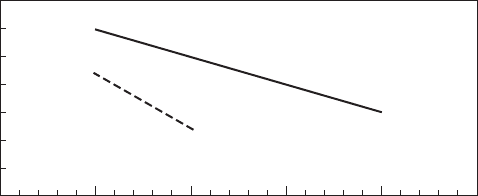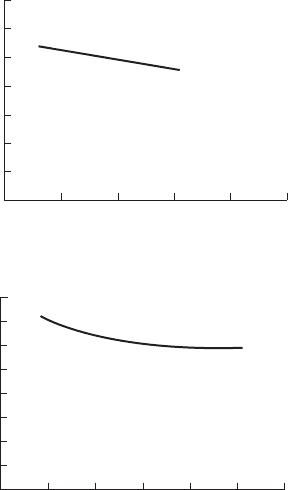Water and Wastewater Engineering
Подождите немного. Документ загружается.


23-78 WATER AND WASTEWATER ENGINEERING
proportional to the mass of biological phosphorus storing bacteria was ted, the phosphorus bio-
mass production is lower so that less phosphorus is removed during wasting. Second, long SRTs
mean that the PAOs are in an extended endogenous phase. This depletes glycogen, which results
in less efficient acetate uptake, and PHB storage will o
ccur in the anaerobic zone. This will make
the overall BPR process less efficient (Stephens and Stensel, 1998).
The relationship between SRT, temperature, and perform ance is described later in this
section. Typical SRTs for the A
2
/O ™ process are 5 to 25 days. As shown in Table 23-9 , the BPR
process selected will strongly affect the choice of SRT. When nitrogen removal is part of the
process as it is with the A
2
/O ™ process, the aerobic SRT for nitrification governs.
Safety factor. Figure 23-21 shows the washout SRT values as a function of temperature and
limiting conditions of COD or phosphorus. SRTs greater than 2.5 days are recommended when
the temperature is 20
C (Mamais and Jenkins, 1992). This implies a minimum safety factor of
1.6 under COD limiting conditions and a safety factor of about 2.5 under phosphorus limiting
conditions. When the aerobic nitrification SRT governs, the safety factor will fall in the range of
2 to 10.
Return activated sludge (RAS). In the A
2
/O
™
process the RAS is returned to the head end of the
anaerobic tank. This is of concern because excessive amounts of nitrate may enter the anaerobic
tank. Heterotrophic bacteria will use nitrate to consume rbCOD. This will reduce the rbCOD
available for PAOs, which, in turn, will reduce the phosphorus removal efficiency. Thus, the
BPR is dependent on the efficiency of the biological
denitrification step. Other BPR processes
avoid this problem by routing the RAS to the anoxic tank.
The RAS pumping system m ust be flex ible enough to allow RAS flow rates that vary from
25 to 100 percent of the influent flow rate.
M ixed liquor suspended solids (MLSS). Typical MLSS concentrations are given in Table 23-9 .
Some plants using the A
2
/O
™
process have operated with MLSS concentrations in the range 800
to 2,000 mg/L, but the typical range is 3,000 to 4,000 mg/L.
3.5
3
2.5
2
1.5
1
0.5
0
0 5 10 15 20 25
SRT, days
Temperature, °C
Phosphorus limited
COD limited
FIGURE 23-21
Effect of temperature and limiting nutrient on aerobic washout SRT
for BPR.
(Data from Erdal, 2002; Erdal et al., 2003; Mamais and Jenkins, 1992;
McClintock et al., 1991.)
SECONDARY TREATMENT BY SUSPENDED GROWTH BIOLOGICAL PROCESSES 23-79
Temperature. Very good BPR performance can be achieved as long as SRT values of 16 and
12 days are provided for temperatures of 5
C and 10
C, respectively. SRTs between 16 and
24 days did not affect system performance at 5
C. At 10
C, SRTs between 12 and 17 days did not
affect system performance (WEF, 2006a).
Recycle streams. Solids processing return flows from sludge thickening, anaerobic digestion,
and sludge dewatering typically contain high ammonia and phosphorus concentrations. The high
concentrations and variable rates of generation will d
egrade the performance of BPR process if
they are added on an ad hoc basis. At a minimum, the rate of flow should be equalized. Adding
these streams when the strength of the influent wastewater is stronger (typically, during day-
time) will help to increase the removal of recycled phosphorus. Separate treatment with chemical
a
ddition is the preferred alternative (Metcalf & Eddy, 2003; WEF, 2006a).
Chemical addition. To achieve phosphorus concentrations below 1.0 mg/L as well as to pro-
vide backup for the BPR process, chemical addition facilities should be provided.
Design Practice for Denitrification. The following paragraphs outline the design practice for
those portions of the BPR process that affect d
enitrification and its relationship to phosphorus
removal. The discussion is focused on the A
2
/O
™
process. Alternative processes will requ ire
modifications of the design practices noted here. These are discussed in Metcalf & Eddy (2003),
WEF (1998), and WEF (2006a).
Hydraulic residence time (HRT). The anoxic tank is typically sized based on the amount of
nitrate to be denitrified. As discusse
d in the previous paragraphs on SBR design practice, two
design approaches are used to check the anoxic HRT. The method used here is a desktop approach
that uses mass balanc es for nitrogen and the specific denitrification rate (Equation 23-52).
Simulation modeling is the alternative approach.
The desk top method
is iterative. The NO
x
formed in nitrification is estimated. The assumed
anoxic HRT and SDNR are used to estimate the amount of NO
x
that can be denitrified in the fill
time. If it is greater than the NO
x
formed, the fill time is acceptable. If it is not, another iteration
with a new anoxic fill time is performed.
The major difference between the computational procedure here and that used for the SBR is
that internal recycle (Equations 23-54 through 23-57) must be considered.
T ypical HRTs for the A
2
/O ™ process vary between 0.5 and 1.5 hours. Typical HRTs for
other processes are given in Table 23-9 .
Internal recycle. Equ ation 23-54 is used to estimate the internal recycle ratio (IR). To meet a
standard of 10 mg/L total nitrogen or less, the design effluent NO
3
-N concentration should be in
the range of 5 to 7 mg/L.
The nitrate concentration in the RAS flow can have a significant adverse effect on the amount
of rbCOD that is available for BPR. The nitrate consumption of rbCOD can be estimated from
the ratio of rbCOD/NO
3
-N used. It is 6.6 g rbCOD/g NO
3
-N (Metcalf & Eddy, 2003).
An internal recycle ratio in the range of 3 to 4 is typical, but ratios in the range of 2 to 3
are also used with lower influent wastewater TKN concentrations. Recycle ratios above 4 are
generally not warranted because the incremental NO
3
-N removal is low and more DO is recycled
to the anoxic tank (Metcalf & Eddy, 2003).
23-80 WATER AND WASTEWATER ENGINEERING
Tankage. A complete mix system with three tanks provides the most efficient tank arrangement.
The design HRT is divided into thirds for the volume estimate. The tanks may stand alone or share
a common wall. When a common wall is used, a broad-crested weir allows flow to move to succes-
sive tanks. The tank
s typically will have the same depth as the anaerobic and aerobic tanks. This is
on the order of 4.5 to 7.5 m with a freeboard of 0.3 to 0.6 m. The plan of the tanks is square.
M ixing. Submersible mechanical mixers keep the biomass in suspension. The mixing should be
just sufficient to keep the bio
mass suspended without entraining air. Typical power requirements
are in the range 3 to 13 W/m
3
.
Solids retention time (SRT). When nitrogen removal is part of the process as it is with the A
2
/O
™
process, the aerobic SRT for nitrification governs.
Return activated sludge (RAS). In the A
2
/O
™
process, RAS is returned to the anaerobic zone
rather than the anoxic zone. Other BPR processes route the RAS to the anoxic tank to avoid add-
ing nitrate to the anaerobic zone.
M i xed liquor suspended solids (MLSS). The MLSS concentration is in the range of 3,000 to
4,000 mg/L. This is the same range as that specified for BPR removal processes.
Temperature. Lower temperatures will lower the specific denitrification rate (SDNR).
Equ
ation 23-55 is used to correct for temperatures other than 20
C.
Alkalinity. About one-half of the alkalinity consumed in nitrification (7.14 g as CaCO
3
) can be
recovered in denitrification. Equation 23-60 is used to determine whether or not alkalinity addi-
tion is needed.
Design Practice for Nitrification. The following paragraphs outline the design practice for
those portions of the BPR process that affect nitrification and its relationship to denitrification
and phosphorus removal. The discussion is focused on the A
2
/O
™
process. Alternative processes
will require modifications of the design practices noted here. These are discussed in Metcalf &
Eddy (2003), WEF (1998), and WEF (2006b).
Modeling equations. Assuming the process kinetics approach that of a completely mixed reactor,
Equations 23-11 through 23-19 are applic
able. For municipal systems, WEF (1998) recommends
that process design using the kinetic approach be based on an effluent soluble substrate concentra-
tion of zero, that is, S = 0. Both carbonaceous oxidation and nitrification are treatment objectives.
Nitrification growth kinetics (Equation 22-28) are assumed to govern (Mandt and Bell, 1982,
U.S. EPA, 1975a). The kinetic coefficients for design of nitrification are given in Table 23-14 .
Solids retention time (SRT). To achieve nitrification, the SRT is typically on the order of 3 to
15 days (Metcalf & Eddy, 2003). Because of its impact on phosphorus removal, shorter SRTs are
preferred.
Safety factor. Based on analy sis of NH
4
-N data at Chapel Hill, U.S. EPA (1975a) developed
Figure 23-18 . From this graph it appears that an SRT safety factor of 2.5 is reasonable to achieve

SECONDARY TREATMENT BY SUSPENDED GROWTH BIOLOGICAL PROCESSES 23-81
an average effluent concentration of less than 1 mg/L NH
4
-N. WEF (1998) uses a safety factor of
2.5 in process design examples.
Hydraulic residence time (HRT). The aerobic tank is sized based on the amount of TKN to be
nitrified. The hydraulic detention time is not a basis for design. Although it appears in tables of
design param eters, it is likewise not
a design criterion. As shown in Table 23-9 , the range of
HRTs for the aerobic tank is quite large: 1 to 12 hours. For the A
2
/O
™
process the typical HRT
is 4 to 8 hours.
Tankage. Completely mixed basins are typically square, but they have been built in round and
rectangular configurations. For rectangular tanks, the length-to-width ratio should be less than
3:1 if mechanical aerators are used. Multiple m
echanical aeration units in long, narrow tanks
(for example, with L:W of 5:1) create a mixing pattern that approaches mixed tanks in series.
Multiple feed points also enhance complete mixing (WEF, 1998).
For mechanical aerators, widths range from 9 to 27 m depending on the aerator size. Depths
range from 3 to 6 m. Freeboard is on the or
der of 1 to 1.5 m. The width and depth of the tank
should be sized based on the power rating of the aerator. Typical aeration tank dimensions are
given in Table 23-18 .
For diffused air systems, the depth of wastewater should be between 4.5 and 7.5 m with a
freeboard in the range of 0.3 to 0.6 m. If the tank geometry is a plug-flow configuration with
spiral-flow mix
ing, the width-to-depth ratio should be in the range of 1:1 to 2.2:1, with 1.5:1
being the most common. The length-to-width ratio should be at least 5:1. For tanks with diffusers
in a grid or panel pattern, greater widths are permissible (Metcalf & Eddy, 2003).
M ixed liquor suspended solids (MLSS). The MLSS is in the range 2,000 to 4,000 mg/L.
D issolved oxygen. For nitrification to proceed uninhibited, the DO must be above 2.0 mg/L. As
noted in Chapter 22, nitrifi
cation rates increase with increasing DO up to about 3 or 4 mg/L.
To minimize the DO that is recycled to the anoxic tank, the aerobic tank DO may be tapered
with a lower DO at the downstream end. In a complete mix tank design, either multiple tanks or a
single baffled tank may be used to reduce mixing of the higher DO wastewater with the effluent
from the aeration tank. In plug-flow tanks, tapering is
accomplished by regu lating the air flow
along the tank.
Return activated sludge (RAS). The RAS is returned to the anaerobic tank. It is not considered
in the design of the aerobic tank.
A dapted from Metcalf & Eddy, 2003 .
Aerator size, kW Tank depth, m Tank width, m
7.5 3–3.6 9–12
15 3.6–4.2 10.5–15
30 3.6–5.1 13.5–20
75 4.5–6 18–27
TABLE 23-18
Typical aeration tank dimensions for mechanical aerators

23-82 WATER AND WASTEWATER ENGINEERING
Alkalinity. A portion of the alkalinity consumed in nitrification is recovered in the denitrifica-
tion process. The estimate of the required alkalinity addition that is made in the design of the
anoxic stage is based on an estimate of alkalinity remaining after the nitrification stage and the
internal recycle ratio.
Aerators. Su rface aerators have typically been use
d in complete-mix systems. The design
process follows the one discussed in Chapter 20 for equalization basin aerator selection.
In new construction, fine bubble diffusers have become common. These may be either
ceramic domed or fine pore membrane diffusers. Full floor coverage is
required to achieve maxi-
mum standard oxygen transfer efficiency (SOTE) and complete mixing (Stenstron and Redmon,
1996). Figure 23-22 illustrates the very high SOTE for full floor coverage. The SOTE per meter
of submergence varies with the air flow rate as shown in Figure 23-23 .
Fine pore diffusers are susceptible to c
hemical and biological fouling. Fouling is generally
classified as one of two types (U.S. EPA, 1999a):
• T ype I: clogging by airborne particulate matter on the air-side or metal hydroxide precipita-
tion on the liquid side.
• Type II: biofilm formation on the diffuser surface.
Preventive maintenance can virtually eliminate air side fou
ling by cleaning and changing the
air filters. Corrective maintenance includes one or more of the following: removal and acid/alkali
wash, high-pressure water jetting, and air bumping.
35
30
25
20
15
10
5
0
2520151050
SOTE, %
Air flux, m
3
/m of diffuser length · h
FIGURE 23-22
Clean water efficiency for full floor coverage with membrane diffuser.
8
7
6
5
4
3
2
1
0
5 643210
SOTE, % per m submergence
Airflow rate, m
3
/h
FIGURE 23-23
Clean water oxygen transfer efficiency for a membrane disc as a
function of flow rate and submergence.

SECONDARY TREATMENT BY SUSPENDED GROWTH BIOLOGICAL PROCESSES 23-83
Approximately 50 to 65 percent of the net power demand for an activated sludge wastewater
treatment plant is for aeration. The higher SOTE of fine pore diffusers may make them well
worth their extra cost and maintenance.
M ixing. In diffused-air systems, the air flow rate required to ensure good mixing varies from
30 to 40 m
3
/ d · m
3
of tank volume (or 400 to 950 m
3
/ d · m of header) for spiral roll aeration. For
full grid systems of fine bubble diffusers, air flow rates of 15 to 20 m
3
/ d · m
3
of tank volume (or
20 to 55 m
3
/ d · m
2
of floor) are suggested (Metcalf & Eddy, 2003; WEF, 1998).
Blowers. There are three types of blowers used for aeration: centrifugal, rotary lobe positive
displacement, and inlet guide vane-variable diffuser. Centrifugal blowers are almost universally
used where free air flow rates are greater than 425 m
3
/ min. The rated discharge pressures range
from 50 to 60 kPa. Rotary lobe positive displacement blowers are used for discharge pressures
greater than 55 kPa, and free air flow rates less than 425 m
3
/ min. The inlet guid e vane-variable
blowers have free air capacities ranging from 85 to 1,700 m
3
/ min at pressures up to 170 kPa
(Metcalf & Eddy, 2003).
To meet the wide range of airflows required, one or more of the following methods may be
employed: (1) flow blowoff or bypassing, (2) inlet throttling, (3) adjustable discharge diffuser,
(4) variable frequency drive (VFD), (5) parallel operation of multiple units. Of these methods, the
VFD has found great acceptanc
e because of its flexibility and the resultant savings in energy costs.
The performance cu rve for a centrifugal blower resembles the head -discharge curve for a
pump. The pressure decreases as the inlet air flow rate increases. Blowers are rated at standard
conditions that are defined as 20
C, 101.325 kPa, and 36 percent relative humidity.
Although there are a large number of factors in selecting a blower/VFD combination, two are
significant in making a process selection. First, is that a multistage blower with a flat performance
curve can be sensitive to changes in ambient air conditions, speed, or discharge pressure. This
can
be mitigated by selection of a blower with a performance curve that rises steadily from the design
point to the surge point with little or no leveling off. Second, good design practice requires a separate
VFD for each blower. Although new VFD designs are not subject to frequent failures, with a one to
one match of VFD and blower, catastrophic aeration failure will be
minimized (Jenkins, 2005).
Blowers must be sized to have capacity for a hot summer day with adequate driver power for
cold winter months. The power requirement for adiabatic compression of air is estimated with the
following equation:
P
wRT
e
p
p
w
29 7 0 283
1
0283
2
1
..
.
()()
⎛
⎝
⎜
⎞
⎠
⎟
⎡
⎣
⎢
⎢
⎤
⎦
⎥⎥
⎥
(23-63)
where P
w
power requirement for each blower, kW
w mass flow of air, kg/s
R gas constant for air, 8.314 kJ/k mol K
T absolute temperature, K
p
1
absolute inlet pressure, atm
p
2
absolute outlet pressure, atm
29.7 constant for SI units conversion
0.283 constant for air
e efficiency (usual range is 0.70 to 0.90)

23-84 WATER AND WASTEWATER ENGINEERING
The required supply pressure at the blower ( p
2
) is the sum of all the headlosses in the air
piping that gives the maximum headloss plus the submergence of the diffusers. Bec ause the
headlosses in the piping and diffusers depends on the supply pressure and temperature of the air,
an iterative procedure is required for the solution.
Blowers are a major sou
rce of noise and heat. Noise suppression techniques should be
e mployed in designing the building that houses the blowers. Occupational Safety and Health and
Administration (OSHA) guidelines must be enforced for employees. Typical criteria are given in
Design of Municipal Wastewater Treatment Plants (WEF, 1998). Introduction to Environmental
Engineering (Davis and Cornwell, 2008) provides an introduction to basic principles of noise
impact and control.
A dequate ventilation must be provided to reduce the heat load on personnel working in the
blower room. OSHA guidelines and the American Society for Heating, Refrigeration, and Air
Conditioning handbooks should be consulted for appropriate design val
ues. As an energy conser-
vation measure, the heat may be used beneficially in heating other buildings in the plant.
Air Piping. Primary considerations in piping material selection are s trength and potential for
corrosion. Typical materials include carbon and stainless steel, ductile iron, fiber glass reinforced
plastic
(FRP), high density polyethylene (HDPE), and polyvinyl chloride (PVC). Steel is typi-
cally used at the blower discharge because of the high temperatures. PVC piping must not be used
above the liquid level in the tank. Thermal and pressure stresses may cause it to explode! Because
thermal stresses
can be significant, provisions for pipe expansion and contraction are required.
Stainless steel is typically used for drop legs and headers for coarse bubble diffuser systems
because of corrosion potential and the load applied by the headers. PVC, placed within the tank,
is more comm
on with fine bubble dome and membrane diffusers.
The headloss in straight pipes carrying air may be estimated with the following equation
(Steel and McGhee, 1979):
h
fLTQ
PD
L
982 10
8
2
5
.
⎛
⎝
⎜
⎞
⎠
⎟
(23-64)
where h
L
headloss, mm of water
f dimensionless friction factor
L equivalent length of pipe, m
T absolute temperature, K
Q air flow, m
3
/ min
P air supply pressure, atm
D pipe diameter, m
The absolute temperature is defined as
TT
P
P
0
0283
0
.
⎛
⎝
⎜
⎞
⎠
⎟
(23-65)
where T
0
ambient temperature, K
P air supply pressure, atm
P
0
ambient atmospheric pressure, atm
It is recommended that the maximum summer air temperature be used for T
0
.

SECONDARY TREATMENT BY SUSPENDED GROWTH BIOLOGICAL PROCESSES 23-85
The dimensionless friction factor ( f ) may be obtained from a Moody diagram or, for steel
pipe, it may be approximated by (Steel and McGhee, 1979):
f
D
Q
0 029
0 027
0 148
.
.
.
⎛
⎝
⎜
⎞
⎠
⎟
( 2 3-66)
Minor losses can be estimated as equivalent length of pipe using the following equation:
LCD 55 4
12
.
.
(23-67)
where L equivalent length of pipe, m
C resistance factor, dimensionless
D pipe diameter, m
Resistance factors are given in Table 23-19 . Other loss estimates are given in Table 23-20 .
Appurtenance
or source
Headloss,
mm of water
a
Air filter 50 to 380
Blower silencers
Centrifugal 50 to 400
Rotary 100 to 800
Check valves50 to 380
Diffusers 75 to 650
Diffuser clogging 150 to 250
Submergence Water depth above diffuse
TABLE 23-20
Other losses for aeration system
a
Equipment manufacturers should be consulted for actual design
data.
TABLE 23-19
Resistance factors for aeration piping fittings
Fitting
C
Angle valve 0.90
Gate valve 0.25
Globe valve 2.00
Long radius ell or run of tee 0.33
Medium radius ell or run of tee reduced 25% 0.42
Standard ell or run of tee reduced 50% 0.67
Adapted from Steel and McGhee, 1979.

23-86 WATER AND WASTEWATER ENGINEERING
Secondary Settling. The design of the secondary settling tank for this system is discussed in
Chapter 25.
Sludge Processing. Anaerobic conditions in thickening and/or digestion of sludge can result
in release of significant amounts of phosphorus. Thus, the recycle streams from these processes
increase the influent phosphorus concentration to the anaerobic stage. This implies the need for a
higher influent rbCOD to produce a low effluent phosphorus concentration.
Thickening of waste sludge by dissolved air flotation, gravity belt thickeners, or rotary
drum thickeners is preferred over gravity thickening to minimize phosphorus release. Direct
land
application of liquid, digested sludge, or dewatered sludge minimizes recycled phosphorus
loads.
Design Examples. The following six example problems illustrate the design of a BPR process.
The design begins at the back end of the process with the aerobic stage to determine the amount
of nitrate formed . This
estimate is used to size the anoxic stage. The anaerobic stage is then
designed. The examples focus on estimation of the SRT and volume of tank required for nitrifica-
tion, nitrate removal capacity, alkalinity requirements, estimation of effluent soluble phosphorus
conc entration, volume and dimension
s of the reac tors, and the aeration system compressor
design.
Example 23-17. Begin the design of a complete-mix BOD removal and nitrification stage for
Tempe’s new BPR wastewater treatment plant. As a first step determine the SRT and volume of
tank required for nitrification using the following design data:
Influent data after primary settling
D e sign flow rate 90,000 m
3
/ d
BOD
5
138 mg/L
bCOD 220 mg/L
rbCOD 80 mg/L
Total Kjeldahl nitrogen (TKN) 35 mg/L
NH
3
-N 25 mg/L
Soluble phosphorus 8 g/m
3
Total suspended solids (TSS) 70 mg/L
Volatile suspended solids (VSS) 60 mg/L
Biodegradable volatile suspended solids 40 mg/L
Minimum sustained temperature 20 C
pH 7.0
Alkalinity 220 mg/L as CaCO
3
Effluent discharge standards
bCOD 20 mg/L
NH
3
-N 1.0 mg/L
NO
3
-N 10 mg/L
TSS 10 mg/L
Total phosphorus 2.0 mg/L

SECONDARY TREATMENT BY SUSPENDED GROWTH BIOLOGICAL PROCESSES 23-87
A ssume DO for aeration tank nitrification 2.0 mg/L; MLSS 3,000 mg/L, MLVSS (0.8) MLSS,
NO
x
80% of TKN, and RAS 0.60(Q).
Solution:
a . Assume that four identical process lines will be built for redundancy and flexibility.
Each line will have a design flow rate of
90 000
4
22 500
3
3
,
,
m /d
m /d
b. Use Table 23-14 for the biokinetic constants because nitrification kinetics govern. The
minimum sustained temperature is 20 C so no temperature corrections are required.
n max
0.75 g VSS/g VSS · d
K
n
0.74 g NH
4
-N/m
3
k
dn
0.08 g VSS/g VSS · d
K
0
0.50 g/m
3
c. Estimate
n
using Equation 23-28. The valu e selected for N is the design effluent con-
centration because that is limiting. The DO is the design DO that must be achieved by
the design of the aeration system. The assumed value is 2.0 mg/L.
n
()075
10
074
3
4
.
.
.-
g VSS/g VSS
g/m
gNH N/m
333
3
33
10
20
0 5020.
.
..g/m
g/m
g/m g/m
⎛
⎝
⎜
⎞
⎠
⎟
⎛⎛
⎝
⎜
⎞
⎠
⎟
⎡
⎣
⎢
⎢
⎤
⎦
⎥
⎥
008
0
.
.
g VSS/g VSS d
n
[( 775 0 57 0 80 0 08 0 262
1
)( )( )].. . .
d
d. Calculate
c min
.
1
0 262
3 817
1
c
n
c
min
min
d
d
.
.=
e. Using a safety factor of 2.5 from Figure 23-18 ,
c
2 53817 9 54.. .()dd
This is within the SRT guidelines for BPR and is at the desirable shorter end of the
range.
f. Using Parts A, B, and C of Equation 23 -40, determine biomass production. Use the
biokinetic constants for heterotrophic bacteria ( Table 23-13 ) for Parts A and B. Use the
biokinetic constants for nitrification for Part C. The minimum
sustained temperature
is 20 C, so no temperature corrections are required. Use a conservative assumption of
